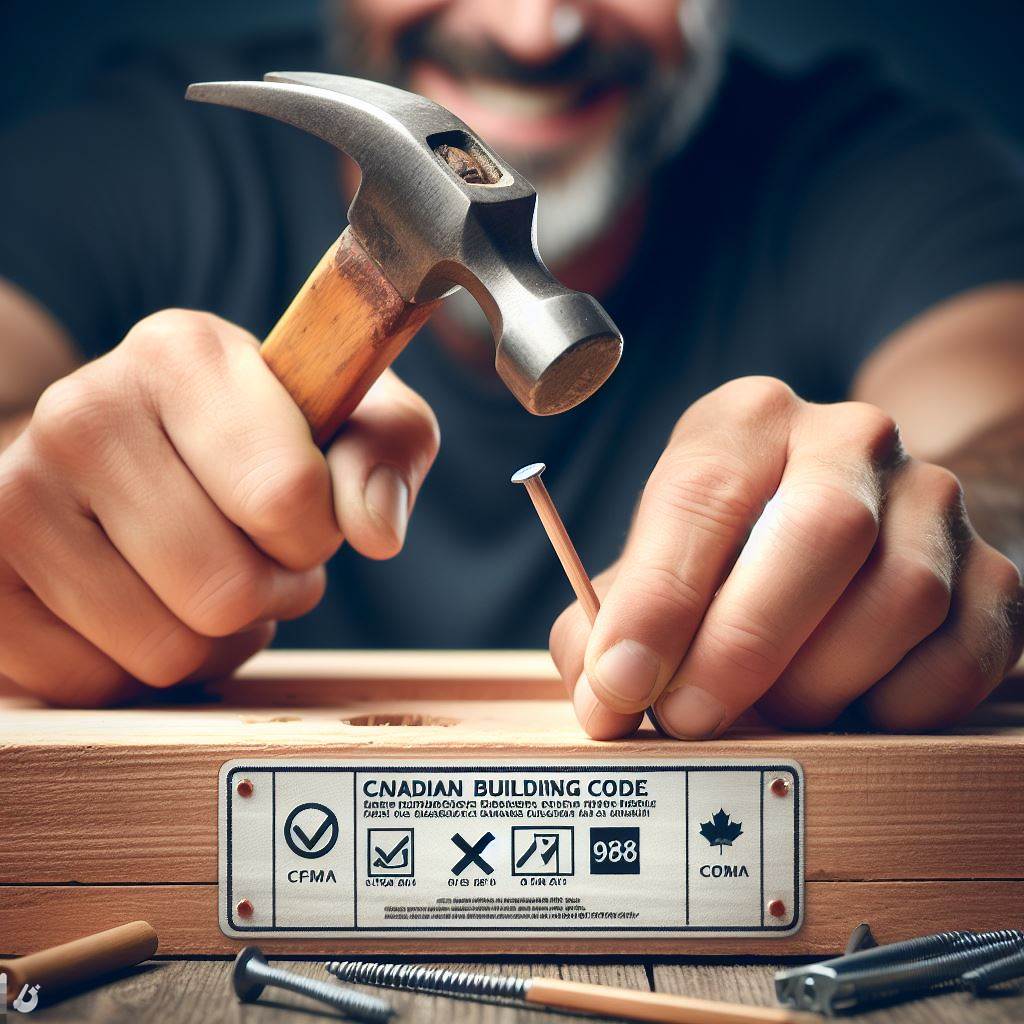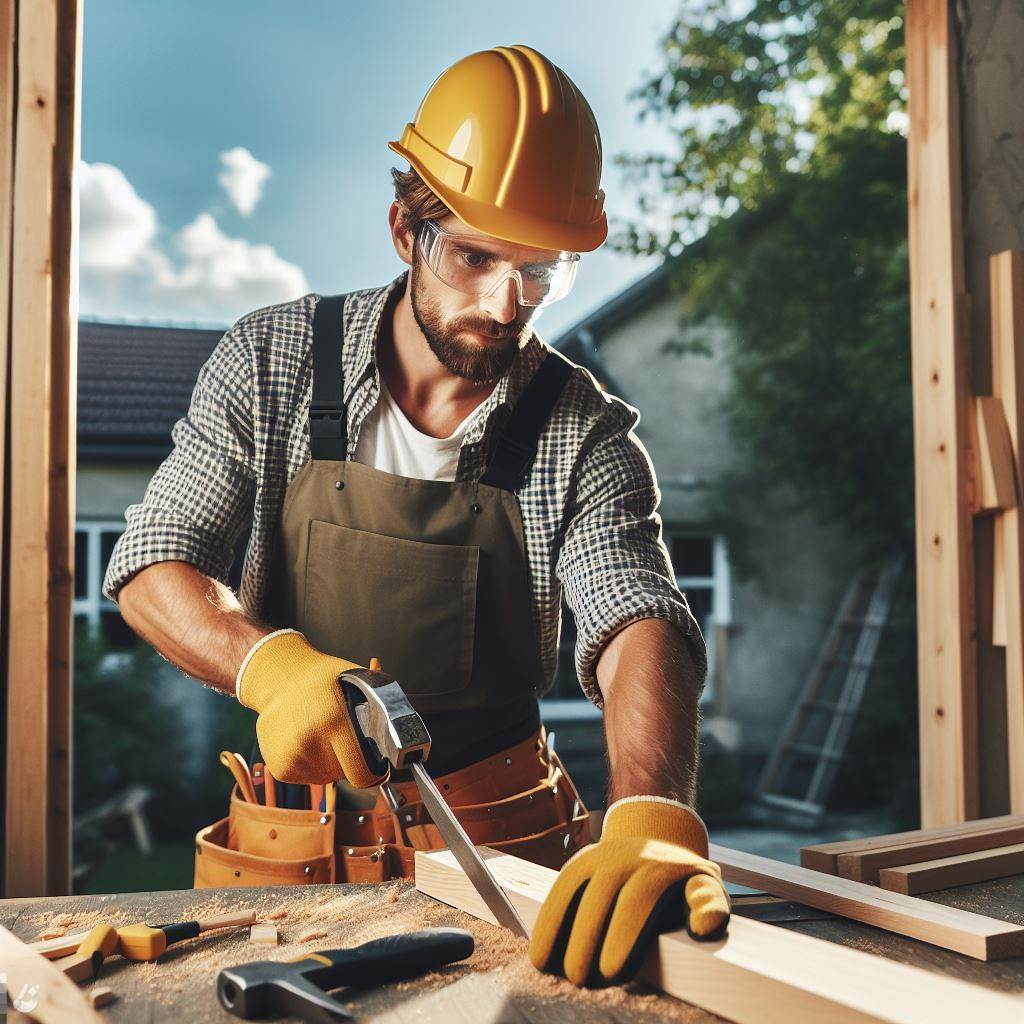Introduction
Safety standards play a crucial role in maintaining a secure and accident-free workplace.
This blog post focuses on carpentry safety standards in Canada, highlighting their significance and implementation.
Navigating the intricate world of Canadian carpentry involves not only honing exceptional skills but also prioritizing the well-being of the workforce.
As we embark on this exploration of Carpentry Safety Standards, we will unravel the multifaceted layers that contribute to a culture of safety in carpentry practices throughout Canada.
From legislative guidelines to industry-specific protocols, we will dissect the frameworks that govern safe working conditions.
Furthermore, we’ll delve into the latest innovations and technologies shaping the landscape, underscoring the industry’s commitment to evolving safety standards.
Join us on this journey through the nuanced tapestry of carpentry safety, where the fusion of tradition and innovation creates a resilient foundation for professionals across the Canadian woodworking spectrum.
Overview of Carpentry Safety Standards in Canada
Significance of Safety Regulations in the Carpentry Industry
- Safety regulations in the carpentry industry are vital to protect workers from accidents and injuries.
- They ensure compliance with health and safety standards to maintain a safe working environment.
- Safety regulations minimize the risk of accidents, which can lead to loss of life, limb, or property damage.
- Following safety regulations helps in reducing insurance claims and related costs for employers.
- Implementation of safety measures enhances the reputation of carpentry businesses and instills trust among clients.
Legal Framework and Governing Bodies for Enforcing Safety Standards
- In Canada, carpentry safety standards are governed by federal, provincial, and territorial laws.
- At the federal level, the Canadian Centre for Occupational Health and Safety (CCOHS) provides guidelines and resources.
- Provincial and territorial governments have jurisdiction over workplace health and safety regulations.
- Regulators such as WorkSafeBC in British Columbia and the Ontario Ministry of Labour enforce these regulations.
- These governing bodies conduct inspections, investigations, and audits to ensure compliance with safety standards.
Main Principles and Objectives of Carpentry Safety Standards in Canada
- Prevention: The primary objective is to prevent accidents and injuries by eliminating or minimizing hazards.
- Education and Training: Employers must provide comprehensive safety training to carpentry workers.
- Hazard Identification and Control: Assessing and controlling workplace hazards to reduce risks.
- Personal Protective Equipment (PPE): Ensuring workers have access to and properly use PPE.
- Equipment Safety: Regular maintenance and inspection of tools and machinery to prevent malfunctions.
- Fall Protection: Implementing measures like guardrails, harnesses, and safety nets to prevent falls from heights.
- Safe Work Practices: Promoting safe work habits, including proper lifting techniques and ergonomics.
- Emergency Preparedness: Planning and drills to respond to accidents, fire outbreaks, or other emergencies.
- Reporting and Investigation: Establishing procedures for reporting incidents and conducting thorough investigations.
- Continuous Improvement: Regular review and updates of safety protocols based on emerging risks and industry advancements.
Adhering to carpentry safety regulations in Canada is crucial to safeguard workers’ well-being, minimize accidents, and create a positive work environment.
The legal framework and governing bodies play a pivotal role in enforcing these standards.
By following the main principles and objectives, carpentry businesses can effectively mitigate risks and ensure a safer work environment.
Remember, safety should always be a priority in the carpentry industry.
Read: Canadian Carpentry: History and Evolution
Common Safety Hazards in Carpentry Work
As carpenters play a crucial role in construction projects, it is essential to recognize the potential hazards they face daily.
Being aware of these hazards and taking necessary precautions can greatly reduce the risk of accidents and injuries.
In this section, we will identify and describe the most common safety hazards faced by carpenters in Canada, discuss potential risks associated with working at heights, handling power tools, and working with wood and other materials, as well as provide statistics and examples to emphasize the importance of avoiding these hazards.
The most common safety hazards faced by carpenters in Canada
1. Working at Heights
Carpenters often work at elevated heights, such as on scaffolding or ladders, increasing the risk of falls.
The improper use of fall protection equipment and inadequate training can lead to severe injuries or even fatalities.
According to statistics from the Canadian Centre for Occupational Health and Safety (CCOHS), falls from heights account for a significant number of workplace injuries among carpenters.
To mitigate this risk, carpenters should receive proper training on fall protection systems and the safe use of ladders and scaffolding.
Implementing guardrails, barriers, and other fall prevention measures can also greatly enhance safety on job sites.
2. Handling Power Tools
Power tools are an integral part of a carpenter’s job, but they also pose potential hazards if not handled correctly.
Improper use of power tools can result in lacerations, amputations, and other severe injuries. Statistics indicate that a significant number of carpentry accidents are related to power tool use.
To minimize these risks, carpenters must receive proper training in the safe operation and maintenance of power tools.
Using appropriate personal protective equipment (PPE) such as gloves, safety glasses, and hearing protection is crucial.
Regular inspection and maintenance of tools is equally important to ensure their safe and efficient functioning.
Unlock Your Career Potential
Visualize a clear path to success with our tailored Career Consulting service. Personalized insights in just 1-3 days.
Get Started3. Working with Wood and other Materials
Carpenters work extensively with wood and other construction materials such as concrete, nails, and fasteners, which can present several hazards.
Wood dust, for example, can lead to respiratory issues or even cancer if inhaled over an extended period. Splinters, sharp edges, and heavy materials can also cause injuries.
Proper ventilation, dust control, and the use of personal protective equipment like respirators are essential when working with wood.
Additionally, wearing cut-resistant gloves, using tools with safety guards, and practicing proper lifting techniques can help minimize the risk of injuries associated with other construction materials.
4. Importance of Avoiding Hazards
The importance of avoiding these hazards cannot be overstated.
It not only ensures the safety and well-being of carpenters but also leads to increased productivity and cost-savings for employers.
Additionally, adhering to safety standards helps organizations maintain a positive reputation and comply with legal requirements.
According to data from the Association of Workers’ Compensation Boards of Canada, carpentry-related injuries result in significant financial costs for both workers and employers.
These costs include medical expenses, workers’ compensation claims, and productivity losses due to work interruptions.
By implementing effective safety measures, these costs can be significantly reduced.
In short, carpentry work in Canada involves several common safety hazards that carpenters need to be aware of and take precautions against.
By understanding the risks associated with working at heights, handling power tools, and working with various materials, carpenters can create a safer work environment for themselves and others.
It is crucial for carpenters, employers, and organizations to prioritize safety, provide adequate training, and regularly assess and improve safety standards to ensure a successful and injury-free work experience.
Read: Navigating Carpenter Unions in Canada
Safety Equipment and Personal Protective Gear
The essential safety equipment and personal protective gear that carpenters should use in Canada
When it comes to carpentry work in Canada, employing the appropriate safety equipment and personal protective gear is crucial.
These measures ensure the well-being and protection of carpenters, helping to create a safer working environment.
The importance of wearing appropriate protective gear
Let’s explore the essential safety equipment and personal protective gear that carpenters should use in Canada:
1. Hard Hats
- Hard hats are a fundamental piece of safety equipment in carpentry.
- They provide head protection against falling objects, bumps, and high impact accidents.
- Always wear a hard hat on construction sites or whenever there is a risk of head injury.
2. Safety Glasses
- Safety glasses shield the eyes from flying debris, dust, and harmful particles.
- They are essential when performing tasks such as sawing, drilling, or using power tools.
- Make sure safety glasses have proper impact resistance and are ANSI-approved.
3. Steel-Toed Boots
- Steel-toed boots are non-negotiable when it comes to foot protection.
- They guard against potential crushing or puncturing accidents on construction sites.
- Choose boots that are comfortable, properly fitting, and meet safety standards.
4. Respiratory Protection
- Respiratory protection is vital in carpentry, particularly when working with wood dust and chemicals.
- Use a respirator that is suitable for the specific pollutants and meets safety standards.
- Ensure a proper fit and regularly check and replace filters to maintain effectiveness.
5. Hearing Protection
- Continuous exposure to loud noises can lead to long-term hearing damage.
- Wear appropriate hearing protection such as earmuffs or earplugs when working with power tools.
- Choose hearing protection with the correct noise reduction rating (NRR) for adequate sound reduction.
6. Safety Harnesses
- When working at heights, such as on scaffolding or ladders, safety harnesses are essential.
- Ensure you are properly trained and experienced in using safety harnesses.
- Inspect and maintain harnesses regularly to guarantee their reliability.
7. Hand Protection
- Protecting hands from cuts, abrasions, and splinters is crucial in carpentry.
- Wear work gloves appropriate for the specific task, ensuring they fit well and provide adequate grip.
- Consider specialized gloves for tasks involving sharp tools or handling hazardous materials.
8. Fall Protection
- Preventing falls is a key priority in carpentry, especially when working at elevated heights.
- Use fall protection equipment such as safety nets, guardrails, or personal fall arrest systems.
- Adhere to regulations and industry standards regarding fall prevention and protection.
Ensuring the use of appropriate safety equipment and personal protective gear is vital for carpenters in Canada.
Hard hats, safety glasses, steel-toed boots, respiratory protection, hearing protection, safety harnesses, hand protection, and fall protection measures are all crucial components in promoting carpentry safety.
By wearing the proper gear consistently, carpenters minimize the risk of accidents, injuries, and long-term health issues.
Remember, prioritizing safety not only protects the individual worker but also contributes to a more secure and efficient work environment.
Read: Crafting a Resume for Carpentry Jobs in Canada

Carpentry Safety Training and Education
Highlighting the Significance of Carpentry Safety Training and Education in Canada
Carpentry is a profession that involves working with various tools and materials, and it comes with its own set of risks.
To ensure the safety of carpenters in Canadian workplaces, it is essential to prioritize carpentry safety training and education.
Requirements for Carpenters to Undergo Safety Training and Obtain Certifications
- Canadian carpenters are required to undergo safety training and obtain relevant certifications to enhance their skills and protect themselves against potential hazards.
- The Occupational Health and Safety Act mandates employers to provide necessary training and education to employees, including carpenters.
- Various safety certifications, such as the Construction Safety Training System (CSTS) and Occupational Health and Safety Certificate (OHSC), are recognized and commonly required.
- Carpenters should also stay updated with safety regulations, codes, and standards set by governing bodies like the Canadian Centre for Occupational Health and Safety (CCOHS) and the Workplace Safety and Insurance Board (WSIB).
Available Training Programs and Resources for Carpentry Safety Education
- The Canadian Construction Association (CCA) offers comprehensive training programs and resources tailored specifically for carpenters.
- The CCA provides workshops and courses on topics like fall protection, hazard identification, control measures, and emergency response.
- Local colleges and trade schools across Canada provide diploma, certification, and apprenticeship programs in carpentry that include safety education.
- Websites like the CCOHS and WorkSafeBC offer online resources, safety guides, and informative materials to promote carpentry safety awareness.
Beyond Training: Implementing Safety Measures in Carpentry Workplaces
While safety training and education are crucial, they must be complemented with proper safety measures in carpentry workplaces.
Employers and carpenters should work together to create a safe working environment:
- Regular safety inspections should be conducted to identify potential hazards and ensure compliance with safety regulations.
- Employers should provide personal protective equipment (PPE) and enforce its use, including safety goggles, gloves, hard hats, and boots.
- Safe work procedures, such as proper use of tools and equipment and best practices for handling materials, should be established and followed diligently.
- Carpenters should be encouraged to report any safety concerns or incidents to their supervisors or designated safety representatives.
- Ongoing safety training and refresher courses should be provided to ensure carpenters stay up-to-date with the latest safety practices and techniques.
In general, carpentry safety training and education play a vital role in promoting a safe working environment for Canadian carpenters.
By enforcing the requirements for carpenters to undergo safety training and obtain relevant certifications, and providing access to comprehensive training programs and resources, we can ensure the well-being of carpenters across the country.
Read: Carpentry Job Market: Canada’s Outlook
Best Practices for Ensuring Carpentry Safety
A set of best practices to promote safety in carpentry work
When it comes to carpentry work, safety should always be a top priority.
Employing a set of best practices can help ensure a safe and productive work environment.
In this section, we will discuss some key practices to promote safety in carpentry:
Maintaining a Clean and Organized Work Area
- Keep your work area free from clutter and debris to minimize trip hazards.
- Place tools and materials in designated storage areas after use to avoid accidents.
- Sweep the floor regularly to prevent the accumulation of dust and sawdust.
Practicing Proper Lifting Techniques
- Before lifting heavy objects, assess their weight and ensure you can handle them safely.
- Bend your knees and use your leg muscles, not your back, when lifting heavy items.
- Ask for assistance or use lifting aids for items that are too heavy to lift alone.
Securing Work Materials and Tools:
- Properly store sharp tools in protective covers or sheaths to prevent accidental cuts.
- Ensure that work materials and tools are properly secured and do not pose falling hazards.
- Use proper techniques when handling power tools to avoid injuries.
Regular Inspections and Maintenance of Equipment and Tools
- Inspect tools and equipment regularly to identify any signs of wear, damage, or malfunction.
- Replace or repair faulty tools and equipment immediately to prevent accidents or injuries.
- Keep a maintenance log to record inspection dates and any repairs or replacements made.
By implementing these best practices, carpenters can significantly reduce the risk of accidents and injuries in their work environment.
Prioritizing safety not only protects the carpenter but also ensures the quality and efficiency of the work.
Remember, safety is not a one-time consideration; it should be an ongoing practice in every carpentry project.
Importance of Reporting and Addressing Safety Concerns
Reporting Safety Concerns in the Carpentry Industry
- Reporting safety concerns is crucial in the carpentry industry to prevent accidents and injuries.
- It allows for timely identification and resolution of potential hazards in the workplace.
- By reporting safety concerns, workers contribute to creating a safer working environment for everyone.
- Safety concerns can include faulty equipment, inadequate training, or unsafe working conditions.
Role of Workers, Employers, and Regulatory Authorities
- Workers play a vital role in reporting safety concerns they observe or experience in their day-to-day work.
- They should not hesitate to communicate safety issues to their supervisors or employers.
- Employers have the responsibility to address safety concerns raised by workers promptly and effectively.
- They should encourage workers to report safety issues without fear of repercussions.
- Regulatory authorities, such as the Occupational Health and Safety Administration (OHSA), play a vital role.
- They enforce safety standards and regulations in the carpentry industry to ensure a safe working environment.
How to Report Safety Concerns
- Workers should follow their organization’s established procedures for reporting safety concerns.
- This can involve reporting to their immediate supervisor, safety committee, or human resources department.
- It is essential to provide detailed and specific information about the safety concern when reporting.
- Workers should include relevant facts, observations, and any supporting evidence to assist in addressing the concern.
Potential Consequences of Neglecting Safety Violations
- Neglecting safety violations can lead to severe consequences, including injuries, disabilities, or even fatalities.
- Workers who neglect to report safety concerns place themselves and their colleagues at risk.
- Employers who fail to address safety concerns may face legal liabilities and damage to their reputation.
- Regulatory authorities may impose fines or penalties for non-compliance with safety standards and regulations.
- Ignoring safety violations can result in decreased productivity and increased absenteeism due to accidents or injuries.
In summary, reporting and addressing safety concerns is of utmost importance in the carpentry industry.
It is the responsibility of workers, employers, and regulatory authorities to ensure a safe working environment.
By promptly reporting safety concerns, workers contribute to the prevention of accidents and injuries, promoting a culture of safety in the industry.
Effective reporting procedures, along with appropriate actions taken to address concerns, will result in a safer and more productive carpentry workplace.
Conclusion
It cannot be emphasized enough how crucial it is for carpenters to adhere to safety standards in Canada.
By following these guidelines, carpenters can ensure the well-being of themselves and their coworkers.
Not adhering to safety guidelines can result in severe consequences, such as injuries or even fatalities.
The physical demands of carpentry work, combined with potentially dangerous tools and materials, make it essential to prioritize safety.
Carpenters should actively contribute to creating a safer work environment by reporting any hazards or potential risks they come across.
By doing so, they help protect not only themselves but also their colleagues.
It is vital for carpenters to understand that safety should never be compromised or taken lightly.
The long-term implications of not following safety standards can be detrimental to one’s health and overall well-being.
By prioritizing safety, carpenters can minimize the chance of accidents, injuries, and lost productivity.
It is everyone’s responsibility to create a culture that values and promotes safety in the carpentry profession in Canada.
Carpentry safety standards play an indispensable role in maintaining a healthy and secure work environment.
Carpenters must recognize the risks involved and actively contribute to ensuring their safety and that of their fellow workers.
Remember, safety should always come first.




